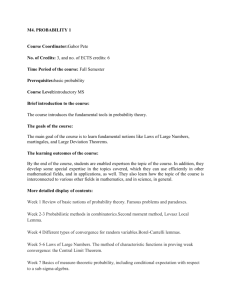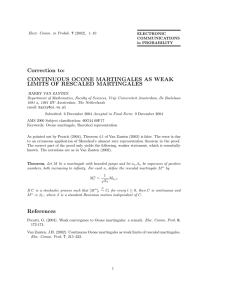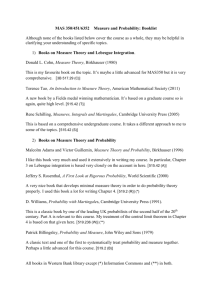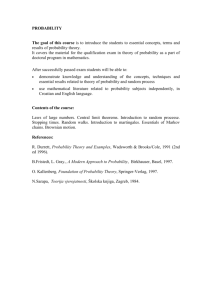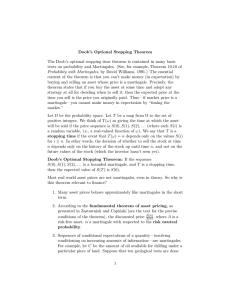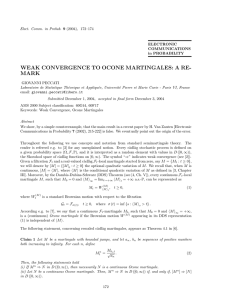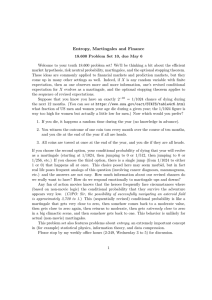My encounters with martingales Klaus KRICKEBERG
advertisement
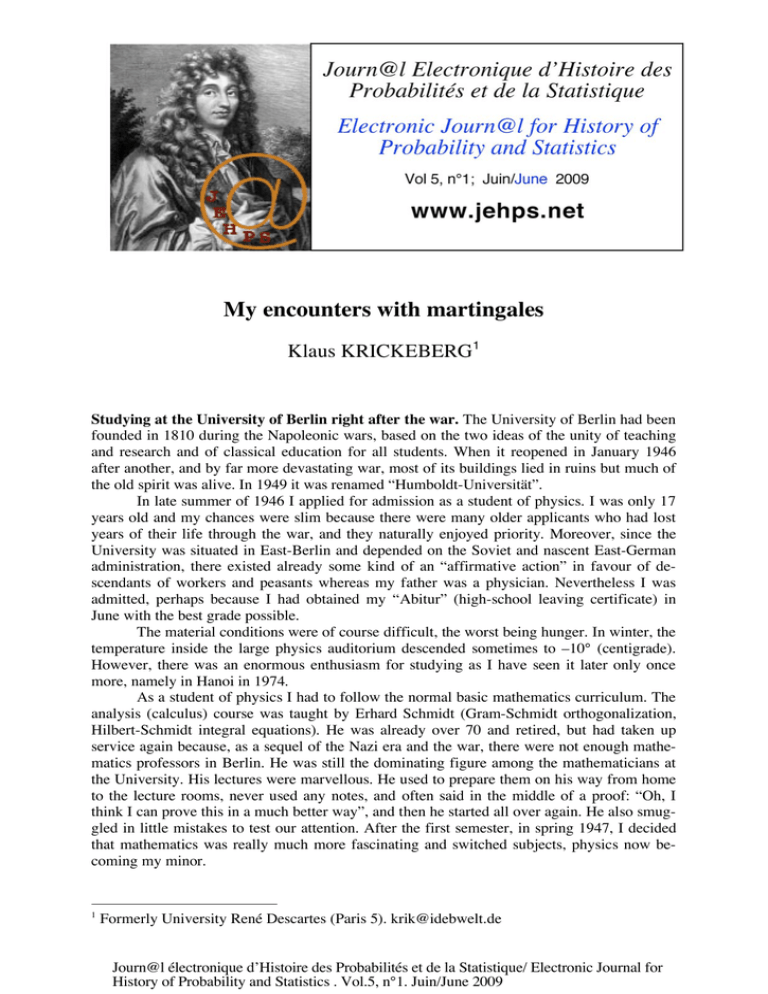
My encounters with martingales Klaus KRICKEBERG1 Studying at the University of Berlin right after the war. The University of Berlin had been founded in 1810 during the Napoleonic wars, based on the two ideas of the unity of teaching and research and of classical education for all students. When it reopened in January 1946 after another, and by far more devastating war, most of its buildings lied in ruins but much of the old spirit was alive. In 1949 it was renamed “Humboldt-Universität”. In late summer of 1946 I applied for admission as a student of physics. I was only 17 years old and my chances were slim because there were many older applicants who had lost years of their life through the war, and they naturally enjoyed priority. Moreover, since the University was situated in East-Berlin and depended on the Soviet and nascent East-German administration, there existed already some kind of an “affirmative action” in favour of descendants of workers and peasants whereas my father was a physician. Nevertheless I was admitted, perhaps because I had obtained my “Abitur” (high-school leaving certificate) in June with the best grade possible. The material conditions were of course difficult, the worst being hunger. In winter, the temperature inside the large physics auditorium descended sometimes to –10° (centigrade). However, there was an enormous enthusiasm for studying as I have seen it later only once more, namely in Hanoi in 1974. As a student of physics I had to follow the normal basic mathematics curriculum. The analysis (calculus) course was taught by Erhard Schmidt (Gram-Schmidt orthogonalization, Hilbert-Schmidt integral equations). He was already over 70 and retired, but had taken up service again because, as a sequel of the Nazi era and the war, there were not enough mathematics professors in Berlin. He was still the dominating figure among the mathematicians at the University. His lectures were marvellous. He used to prepare them on his way from home to the lecture rooms, never used any notes, and often said in the middle of a proof: “Oh, I think I can prove this in a much better way”, and then he started all over again. He also smuggled in little mistakes to test our attention. After the first semester, in spring 1947, I decided that mathematics was really much more fascinating and switched subjects, physics now becoming my minor. 1 Formerly University René Descartes (Paris 5). krik@idebwelt.de Journ@l électronique d’Histoire des Probabilités et de la Statistique/ Electronic Journal for History of Probability and Statistics . Vol.5, n°1. Juin/June 2009 Schmidt’s five semesters’ (two and a half years’) course covered calculus, functions of a complex variable and elliptic functions. Traditionally, calculus in the second semester in Germany meant differentiation and Riemann integration for functions of two real variables. Instead he started out by presenting set theory, very concretely in the plane but in such a suggestive way that we were prompted to invent by ourselves the axioms of Boolean algebra. Then he did abstract measure theory, following the approach of his longstanding friend Constantin Carathéodory, but again in the concrete setting of the plane, and led us directly to the Lebesgue integral. In the second year he taught, in parallel to functions of a complex variable via the “Riemann” approach, a course on “Complements to calculus” which consisted in fact of functional analysis and some other advanced topics. Erhard Schmidt was really a geometer. He could “see” what was happening in infinitedimensional spaces. When he described a projection in a Hilbert space (a Perpendikel in his vivid terminology), he showed it to us with his hands. It is this geometric approach that I have taken later when dealing with martingales, after his teaching of measure theory had lead me into probability theory via some detours. Collecting building blocks for martingale theory. Schmidt retired in 1950, this time for good. Thus he could not guide my Doctor’s Thesis, but it was definitely inspired by him and dealt with geometric measure theory and locally Lipschitzian manifolds. I obtained the (German) Doctor’s degree in 1952 and became a lecturer at Humboldt-University and scientific collaborator of the German Academy of Sciences at Berlin. There I came into contact with the group that ran the reviewing journal Zentralblatt für Mathematik und ihre Grenzgebiete. During the war and the first years after many mathematical journals had ceased to arrive in Germany. Hence it was decided to publish a “Lückenband” (gap volume) where these missing papers would be reviewed. For this volume I was asked to review among others two papers by Børge Jessen and Erik Sparre Andersen on limit theorems for “integrals” [1] and “set functions” [2], respectively. It was about martingales as we know now but the word “martingale” did not appear nor had I ever heard of it. Later on I became aware of a paper of de la ValléePoussin [3] from the year 1915 in which he had already proved almost sure convergence of martingales formed by discrete random variables. In 1950 and 1952 I attended the annual meetings of the German Mathematical Association (DMV). There I met Otto Haupt, a versatile mathematician from Erlangen who had co-authored with Georg Aumann an advanced text on differential- and integral calculus. He was about to prepare a new edition together with a third author, Christian Pauc from France. Pauc had come to Germany in the early forties as a prisoner of war, and Haupt had managed to get him out of the prisoner’s camp and bring him to Erlangen to do abstract mathematics with him. After the war, Pauc was promptly accused of “collaboration with the enemy” and could not get a position in France, so he had to exile himself with his family to South Africa. He came finally back some years later to take up a professorship in Nantes (where the street in which the School of Technology of the University is situated, is now named after him!) Haupt asked me to read the typewritten manuscript of the new edition of the “HauptAumann-Pauc” [4]. I agreed. It arrived in small instalments and I sent back fairly long comments. The authors tried to treat not only integration, i.e. measure theory, but also differentiation in the most abstract setting possible. Motivated by early work of de Possel [5], Pauc had worked on differentiation of generalized interval functions (cell functions) in South Africa with C. A. Hayes [6]. The main issue was a general version of Lebesgue’s theorem to the effect that every function of bounded variation defined in an interval is almost everywhere differentiable. These versions in abstract spaces were based on generalizations of Vitali’s covering theorem. I then proved [7] that conditions of the Vitali type were also necessary in order that certain statements on upper and lower derivatives be valid. Journ@l électronique d’Histoire des Probabilités et de la Statistique/ Electronic Journal for History of Probability and Statistics . Vol.5, n°1. Juin/June 2009 In May 1953 I left Berlin and moved to Würzburg together with the managing director of the Zentralblatt. He had accepted a full professorship there and created a small research team in which I got a temporary position. I read a lot and noticed that probability theory and measure theory were not unrelated. In particular I perused the book by J. L. Doob [8] that had just appeared where he presented the martingale convergence theorems that he had obtained independently of Jessen and Sparre Andersen. Both versions are essentially equivalent and he analysed the fine differences. Doob’s approach via “upcrossing inequalities” permitted him to treat also semi-martingales. Next I discovered the counterexample by Dieudonné [9]. It concerned increasing martingales that are countable Moore-Smith sequences instead of ordinary sequences, i.e. they are indexed by a general countable directed set instead of the positive integers. It showed that even under the usual boundedness conditions, such a martingale need not converge almost surely. On the other hand, I realized that Lebesgue’s differentiation theorem for a function f could be formulated as a theorem on the almost sure convergence of the martingale whose (non-denumerable) index set consisted of all decompositions of the interval in which f was defined, into a finite number of subintervals. The semi-order relation in this set which makes it “directed” is “to be a subdivision”, and the sigma-algebra whose index is a given decomposition is the one generated by it. I then tried to formulate a generalized Vitali condition concerning any increasing martingales with a directed index set, countable or not, that would imply almost sure convergence (leaving aside a technical discussion of “separability”). This was indeed possible. It turned out that in the case of an increasing martingale of bounded variation (i.e. bounded in L1) with a totally (linearly) ordered index set, this condition was trivially satisfied, which yielded another proof of Doob’s theorem for discrete or continuous parameters (indices) without using upcrossing inequalities. In the context of classical differentiation theory, the Vitali condition was satisfied by Vitali’s covering theorem, which gave Lebesgue’s theorem as a particular case. When I started this work, two technical questions were still open. Firstly, my proof worked only for positive martingales. By generalizing the Jordan-decomposition of functions of bounded variation I showed that every martingale of bounded variation is the difference of two positive ones (Krickeberg decomposition). The second question concerned passing to the limit under an integral sign. By chance, Zentralblatt assigned to me for reviewing a book in Italian by Cafiero [10] on set functions, which, although marred by several basic errors, contained a lot on uniform integrability that solved my problem. At the International Congress of Mathematicians in Amsterdam in 1954 I met Børge Jessen and told him about my preoccupations. He then stated the problem of finding a single proof of the almost sure convergence of both increasing and decreasing martingales. Six years later I had the pleasure of giving a lecture in Copenhagen in his presence (in Danish) on the solution of this problem. This lecture took place at the end of my stay at the University of Aarhus (Denmark) as a visiting professor during the academic year 1959/60. Erik Sparre Andersen was then a professor in Aarhus but no longer interested in martingales. A year in Illinois. In Amsterdam I had also talked to Jerzy Neyman about possibilities of spending some time in the United States. He advised me very kindly regarding studies in Berkeley, but I finally decided to apply for a Research Associateship at the University of Illinois in order to work with Doob. I obtained it and also a Fulbright “travel only” grant, which paid my voyage in fall 1955 on board of the French steamship “Liberté” (which had been German before the war). I had just got my “Habilitation” at the University of Würzburg, a degree that might vaguely be described as being a little bit above the Ph.D., and this entitled me to a First Class ticket for the “Liberté”. I still vividly remember my first meeting with Doob in his office in the University at Urbana, Ill. When I presented my results to him he said “Oh, that’s interesting” and suggested Journ@l électronique d’Histoire des Probabilités et de la Statistique/ Electronic Journal for History of Probability and Statistics . Vol.5, n°1. Juin/June 2009 that I publish them in the Transactions of the American Mathematical Society [11]. He also told me about the new work of Paul André Meyer on stopping times and martingales, which initiated the well-known development that was to exert a dominating influence on the theory of stochastic processes indexed by a time parameter. I continued being interested in martingales indexed by a directed set and ran a seminar on the topic. A young mathematician from Taiwan, Y. S. Chow who was at the University of Illinois with a research grant refined the theory based on Vitali conditions in several ways [12]. The Thesis by Helms [13] went into a different direction. He obtained the mean convergence in Lp for any uniformly integrable increasing martingale with a directed index set. I then proved a theorem which, in any systematic presentation, ought to be stated before tackling questions of almost sure convergence under such and such condition, namely that every L1bounded increasing semi-martingale with a directed index set, countable or not, converges stochastically [14]. As a curiosity it might be mentioned that this contains the RadonNikodym theorem as a particular case, the “Radon-Nikodym integrand” being obtained by “stochastic differentiation”. During this academic year 1955/56 I met L. C. Young from the University of Wisconsin who ask me to spend the following year with him, again as a Research Associate. I liked the idea of abandoning martingales for a while and going back to subjects related to my Thesis. It became a very fruitful year, too, with work on geometric measure theory, Laurent Schwartz distributions in Rn for n > 1 and the like. In the summer of 1957 I sailed back to Le Havre, spent a few days in Paris as arranged by Pauc, and then returned to Würzburg and to martingales. Final work till 1964. In the following papers, in order to get rid of the complicated discussions around the concept of a separable stochastic process indexed by a non-denumerable set, I dealt with essential convergence instead of almost sure convergence; in the separable case and in particular for a denumerable index set, the two are trivially equivalent. Proving convergence theorems for decreasing martingales and semi-martingales analogous to those obtained before in the increasing case was not very hard including a counterexample along the lines of the one that Dieudonné had constructed in the increasing case [15]. The problem of the necessity of Vitali conditions for essential convergence was treated in [16]. There, a whole family of Vitali conditions was defined, each of them corresponding to an Lp space and more generally, following a suggestion by Leopold Schmetterer made in 1958 at a colloquium in Paris, to an Orlicz space. Finally, the paper [17] written jointly with Pauc gave a survey on the whole area of increasing or decreasing martingales and their relations with the finer differentiation theory of functions of several real variables and with differentiation in general spaces. Schmetterer was, among others, a number theorist and statistician. At his invitation I spent the summer 1958 as a senior assistant (Oberassistent) at the University of Hamburg. In the fall of that year, I was offered a full professorship for probability theory and statistics at both the Universities of Cologne and Heidelberg of which I accepted the latter. This meant of course a lot of new work. I had to learn about modern statistics; my only previous experience had been guiding a physician in Würzburg through very simple clinical trials. I also came into contact with many other facets of probability theory and did not want to stay with martingales. However, there still was Børge Jessen’s problem. In order to solve it I looked at any family (Moore-Smith sequence) of sigma-algebras indexed by a directed set but no longer necessarily increasing or decreasing as it is in the case of a family underlying a martingale. Each sigma-algebra defines a corresponding conditional expectation operator in a suitable space L of random variables, e.g. in L1. It turned out that one can define a Vitali condition (whose form depends on L) which implies, for every random variable X in L, essential con- Journ@l électronique d’Histoire des Probabilités et de la Statistique/ Electronic Journal for History of Probability and Statistics . Vol.5, n°1. Juin/June 2009 vergence of the corresponding “trajectory”, i.e. of the family of the conditional expectations of X with respect to the underlying sigma-algebras. This condition is trivially satisfied if the family of sigma-algebras is increasing or decreasing. Thus, the classical martingale convergence theorems by Jessen, Sparre Andersen and Doob, both in the increasing and decreasing case, are indeed particular cases of this general theorem. In 1963 I was invited to the All-Union Congress of the Soviet probabilists and mathematical statisticians in Tbilisi. A. N. Kolmogorov chaired the session where I spoke (in Russian) about my general convergence theorem, which I had presented three year before in Copenhagen but not yet published; it then appeared in [18]. The congress was memorable in many respects. Kolmogorov gave a statistical analysis of Pasternak’s poetry although the latter had no odour of sanctity with Soviet authorities. I also met H. Cramér for the first time. The All-Union Congress marked farewell to martingales for me. Much later I started working on point processes. The theory of point processes on the real line makes much use of martingales but again, I was interested in processes in more general spaces and thus got into stochastic geometry and geometrical statistics [15, 16, 17]. I am glad I was never tempted to get involved in the applications of martingales to the theory and, worse, the practice of financial speculations that have contributed in no small measure to the present crisis of the world’s money markets and economy. References 1. Jessen, B. and E. Sparre Andersen: Some limit theorems on integrals in an abstract set. Det Kongelige Danske Videnskabernes Selskab, Matematisk-fysiske Meddelelser nr. 14, 22 (1946), 29 pp. 2. Jessen, B. and E. Sparre Andersen: Some limit theorems on set-functions. Det Kongelige Danske Videnskabernes Selskab, Matematisk-fysiske Meddelelser nr. 5, 25 (1948), 8 pp. 3. de la Vallée-Poussin, C.: Sur l’intégrale de Lebesgue. Trans. Amer. Math. Soc. 16. 435-501 (1915) 4. Haupt, O., Aumann, G. and C. Y. Pauc: Differential- und Integralrechnung III. 2nd ed., de Gruyter, Berlin (1955) 5. de Possel, R.: Sur la dérivation abstraite des fonctions d’ensemble. J. Math. Pures appl. IX, s. 15, 391-409 (1936) 6. Hayes, C. A. and C. Y. Pauc: Full individual and class differentiation theorems in their relations to halo and Vitali properties. Canad. J. Math 7, 221-274 (1955) 7. Krickeberg, K.: La nécessité de certaines hypothèses de Vitali fortes dans la théorie de la dérivation extrème de fonctions d'intervalle. C. r. Acad. Sci., Paris, 238, 764-766 (1954) 8. Doob, J. L.: Stochastic Processes. John Wiley & Sons, New York (1953). 9. Dieudonné, J.: Sur un théorème de Jessen. Fundam. Math. 37, 242-248 ((1950) 10. Cafiero, F. :Funzioni additive d'insieme ed integrazione negli spazi astratti. Ed. Liguori, Napoli (1953) 11. Krickeberg, K.: Convergence of martingales with a directed index set. Trans. Amer. Math. Soc. 83, 313- 337 (1956) 12. Y S Chow, Thesis. University of Illinois, Urbana, Ill. (1958) 13. Helms, L. L.: Convergence properties of martingales with a directed index set. Thesis. Purdue University, Lafayette, Ind. (1956) 14. Krickeberg, K.: Stochastische Konvergenz von Semimartingalen. Math. Zeitschr. 66, 470486 (1957) Journ@l électronique d’Histoire des Probabilités et de la Statistique/ Electronic Journal for History of Probability and Statistics . Vol.5, n°1. Juin/June 2009 15. Krickeberg, K.: Absteigende Semimartingale mit filtrierendem Parameterbereich. Abh. math. Sem. Univ. Hamburg 24, 109-125 (1960) 16. Krickeberg, K.: Notwendige Konvergenzbedingungen bei Martingalen und verwandten Prozessen. Trans. Second Prague Conf. Inform. Theory, Statist. Decision Functions, Random Processes, 1 – 6 June 1959. Publishing House Czechoslovak Acad. Sciences, Prague (1960) 17. Krickeberg, K. and Chr. Pauc: Martingales et dérivation. Bull. Soc. Math. France 91, 455544 (1963) 18. Krickeberg, K.: Convergence of conditional expectation operators (in Russian). Teor. Verojatn. Primen. 9, 595-607 (1964) 19. Krickeberg, K.:Invariance properties of the correlation measure of line processes. Izvestija Akad. Nauk. Armjan. SSR, Ser. Fiz.-Mat. Nauk 5, 251-262 (1970). Reprinted in: Stochastic Geometry (ed. E. F. Harding and D. G. Kendall), pp. 76-88. Wiley, New York (1974) 20. Krickeberg, K.: The Cox process. Symp. Math. 9, Calcolo Probab., Teor. Turbolenza 1971, 151-167 (1972) 21. Krickeberg, K.: Lectures on Point Processes (in Vietnamese). Mathematical Institute, Hanoi (1976) Journ@l électronique d’Histoire des Probabilités et de la Statistique/ Electronic Journal for History of Probability and Statistics . Vol.5, n°1. Juin/June 2009
